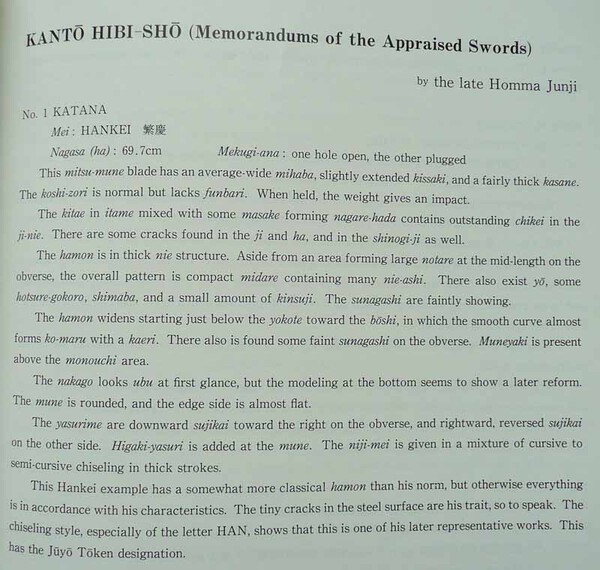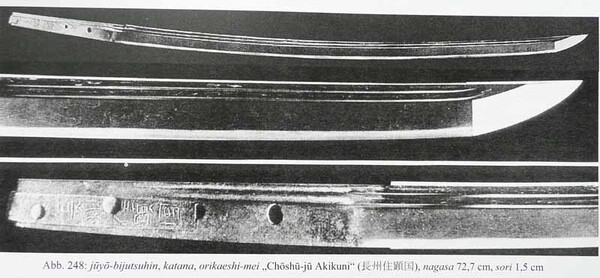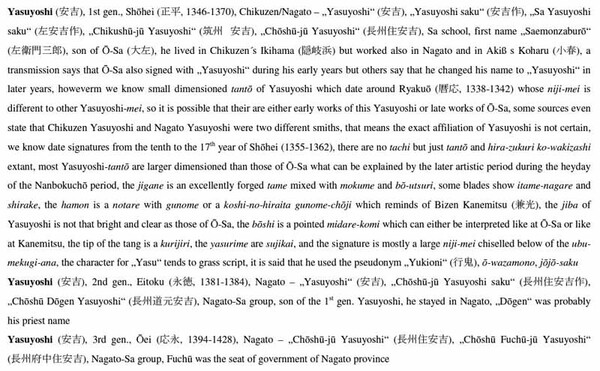-
Posts
1,029 -
Joined
-
Last visited
Content Type
Profiles
Forums
Events
Store
Downloads
Gallery
Everything posted by Eric H
-

Original prices of gendai-to (and shinshin-to)
Eric H replied to Bruno's topic in Military Swords of Japan
-
The Periodic Appreciation Meeting TB 20 - Kantei - HANKEI - “... his jigane is always characterized with the flaws named ji-ware and ko-kizu resulting from insufficient forging for bringing the two edges of the folded metal perfectly together. However such flaws are equivalent to what we call masa-ware that are present in works of the Yamato Hosho school, and instead of considering them defective they have been accepted as important features“. The significance of Hankei‘s „trait“ is unmistakably explained now I believe. Eric
-
However, the statement by Chris Bowen is absolutely correct and in accordance with what is teached by renowned experts. Eric
-
Chikurin no shichi Kenjin I like this attractive Tsuba that has gotten a new life under the skillful hands of Ford Hallam Eric
-
Jacques D. Post subject: Re: Please explain this hardening for me. PostPosted: Fri Nov 30, 2012 11:04 am Offline Sai Jo Saku Joined: Mon Sep 10, 2007 8:51 pm Posts: 1915 Hi, Quote: Eric H but in his case these kizu are not considered as flaws, but as a characteristic of his workmanship, Jacques D. (Reply) About Hankei, it is said that this kind of kizu were not considered as flaws nevertheless they are not considered as a kantei point. :roll: In the above the words „kantei point“ in my comment aren't visible, there is about „characteristic“. I used „in some case this is an important kantei point“ in relation to muneyaki when it comes to individual smiths and schools, as mentioned earlier, the pic is from Kokan Nagayama‘s book. In connection to Hankei I have never asserted, that his kizu are a kantei point, one time I used the term „factor“ but „feature“ had possibly been the better choice. The premi.co Hankei sword, added by Jacques D., however describes the existence of kizu. The translation is far away to be satisfactory, but the essential is visible, but i don't know if this is directly related to the sword or solely a general remark on his workmanship. Eric
-
You didn‘t read carefully: „of course aside of other characteristics of his workmanship“ as well I wrote: „kizu, sometimes but not always seen in his hada“ The proceeding of kantei, sword appraisal, is unmistakably defined as well the comment by Sensei Honma Junji on the significance of the kizu in Hankei‘s workmanship. Any constructed interpretation against Honma Junji's comment is evidence of negating facts! Generally said, an „Amateur“ opinion can be registered but an „Expert“ opinion should be appreciated and followed by the serious collector. BTW if not noticed: „Muneyaki is present above the monouchi“ Supposing I would go to Hankei in a Kantei, when noticing small cracks on a blade, is ridiculous. Eric
-
Kantei is a methodical approach to identification of a sword‘s maker by examination of its shape and characteristics of workmanship. In the case of Hankei‘s workmanship the kizu, sometimes but not always seen in his hada. Sensei Honma Junji: „The tiny cracks in the steel surface are his trait, so to speak“. In my understanding this is a important factor in Kantei, of course aside of other characteristics of his workmanship. Eric
-
You refer to the Yoshifusa Kokuho Tachi. The existence of solely one spot is evidence of imperfect workmanship?, Ok., and people generally do not remove it from older blades. The explanations on unwanted results by imperfect workmanship are instructive. Martin, Hankei is a very famous Shinto swordsmith, Saijo saku, who aimed to make swords in the style of Etchu Norishige. His jihada commonly called „hijiki hada“ is o-itame mixed with itame. Many of his swords show small kizu and ji-ware in the hada, but in his case these kizu are not considered as flaws, but as a characteristic of his workmanship, but muneyaki doesn‘t belong to his characteristics. Point 2 - I‘m grateful if someone can show a pic based on Brian‘s definition. Eric
-
Muneyaki is not a kantei point for Hankei, rather his jigane sometimes showing jiware and other kizu...in his workmanship they are not considered flaws as they would be judged by any other smith. However the following description indicates muneyaki and I think this is accidentally. I don‘t have a pic or oshigata of this sword. What I try to say is... muneyaki accidentally on a collectible sword is not a flaw per se. Shirake utsuri, also is unintentionally made, and it is said, that it is not desirable to have it on a sword, but nobody would have the stupid idea to remove it, just because it is of accidental origin. A picture is worth a thousand words, so I‘d like to see muneyaki on a collectible sword that should be removed because of aesthetic reason. Mei: Hankei Length: 2 shaku 3 sun 2 bu Sori: slightly over 5 bu Design: shinogi zukuri Mune: mitsumune Jihada: o-itame, itame hada mixed with mokume hada, and the hada is a bit rough. There are dense thick ji-nie, fine chikei, and muneyaki. Hamon: Around the machi there is a narrow yakidashi, notare and o-notare, mixed with gunome, has fine sunagashi, kinsuji, frequent ko-nie, dense and thick nioi, and the entire whole hamon has a worn down nioiguchi. Boshi: the omote isa straight yakizume, and the ura is straight with an omaru style, and both tips have fine hakikake. Eric
-
I don‘t doubt on this. But how does one know „this is intentionally made and that is not“?...operating manual... ... Anyway I have never read an issue on this subject by a renowned scholar. If it is desirable to have it on a blade is another question and depends on one‘s own preference. Eric
-
Kunitaro san Some examples from Internet, I cant see any remark that would qualify muneyaki as a kizu or as a sign of poor workmanship. Possibly I will take some pictures of the muneyaki on my sword. Munemitsu 50.2 cm „with muneyaki on the shinogi“ http://www.aoi-art.com/sword/wakizashi/11052.html Morimichi 62.6 cm „there is light muneyaki“ http://www.nihontocraft.com/Musashi_Mor ... atana.html Tameie Riheinojo 69.85 cm „all of them have muneyaki“ http://www.nihontoantiques.com/fss40.htm Rai Kunihide „phenomenal jinie and muneyaki“ http://www.sho-shin.com/ss2-6.pdf Naginata 52.2 cm „muneyaki on back ridge“ http://www.sanmei.com/contents/media/F2 ... PUP_E.html Muramasa II „muneyaki drifts in rivers...“ Eric
-
muneyaki...a kind of flaw (kizu) ? The nature of kizu is precisely defined in literature without any reference to muneyaki. Muneyaki, incidentally or by lack of workmanship, in some case it is an important kantei point. There are smiths and schools associated with muneyaki. I own myself a sword that displays muneyaki...I would never consider to remove it, it belongs to the sword and the sword‘s authenticity must be respected...any „cosmetic repair“ as described is perhaps acceptable on newly made swords. Muneyaki by intent is well explainable by fighting techniques as Jean has written in his comment...but it doesn‘t weaken the blade, the contrary may be right. Eric
-
Mike Y. From your new acquisitions, several times announced, is nothing to see on your website. Why awake interest and then not deliver facts? Eric
-
Brian, the pictures you have posted and the explanations are convincing :D Eric
-
Indeed the shape, proportions and measures, make it plausible that this is intended as a „Child‘s Katana“ from start, rather than a blade has been modified and thinned down. I‘d like to draw your attention on the Nakago-jiri, it is different from all examples I have in my library. Eric
-
General information on Osafune Yasumitsu His swords normally exhibit utsuri -bo utsuri as also midare utsuri-, does your Wakizashi show utsuri? The Ko-Wakizashi from Quiz 208 was offered with Koshirae for JPY 1,800,000 http://www.nihonto.com/abtartshodaiyasumitsu.html viewtopic.php?f=3&t=14100&start=0 http://www.aoi-art.com/kantei/kantei50.html - Appraisal Quiz 50 http://www.aoi-art.com/kantei/kantei51.html - Apraisal Answer 50 http://www.aoi-art.com/kantei/kantei208.html - Appraisal Quiz 208 http://www.aoi-art.com/kantei/kantei209.html - Appraisal Answer 208 Eric
-
Andrey Trepshin I can only shake my head about your long-winded explanations on the uniqueness of this published Tachi, valued at $ 80‘000‘000 by experts who are absolutely unknown in the sword world. The forwarded arguments by knowledgeable people of this board against your unproven theories fizzle ineffective. Don Quixote fighting windmills. However the best advice has already been given. IN FACT...SEND IT TO Japan FOR SHINSA The recognized experts of NBTHK will open your eyes about the "artistic value" of this Tachi, but I‘m inclined to believe they will even not accept it in this unpolished condition. AND DO NOT FORGET TO MAKE INSURANCE FOR $ 80‘000‘000 WHEN SENDING TO Japan. Good luck Eric
-
Well this is exactly the confirmation of what I have written in my comment. Thanks Conclusion: The Nagato Akikuni Katana, Oei period, with Sayagaki by Tanzan, is a prospective candidate for Tokubetsu Hozon. Eric
-
I have looked at the mentioned passus. If I‘m not totally wrong (caused by bad www translation, then please apologise) it says that mumei works of the Muromachi and Edo period will pass Shinsa as Tokubetsu Hozon, given that they are masterpieces by famous toko and in excellent condition. Eric
-
The counterpart to Katsuhira's Tiger...stunning! Eric
-
Kunitaro san, In this context is the Nanbokucho period (1331-1393) an integral part of Muromachi? Eric
-
Well, both works are by Honma Junji sensei, as said the Nihon-Koto-Shi (History of Koto) is the later edition that eventually includes new findings about genealogies. The sayagaki by Tanobe sensei is precious as he writes these opinions on swords that are Tokubetsu Hozon quality or higher...and it adds to the value of the sword. Eric
-
I don‘t have the Nihon to Koza, all I know that this extensive work dates from the mid 1930-ties and was later translated by Afu Watson...btw who is the author? The Nihon-Koto-Shi was as previously mentioned published in 1958. That said, 20 years more of research is involved in Honma sensei‘s work. The site you have provided is very interesting, there are listed 2 Akikuni, one to be the son of Sa, the other the son of „another“ Akikuni, and what is most surprisingly, both had the working period in Oei 1394-1428. Seems to be difficult to understand... Eric
-
Why then the name Akikuni if he was the son of Nidai Sa Yasuyoshi ?... there is already a 3rd. gen. Yasuyoshi According to the Sesko Lexicon: The 2nd gen. Yasuyoshi 1381-1384 The 3rd gen. Yasuyoshi 1394-1428 Akikuni 1st gen. is with working date 1394-1428 Anyway In the Nihon-Koto-Shi by Honma Junji, first published in 1958, Akikuni 1st gen. is explicitly named as a student of Sa Yasuyoshi. Thanks for the pic and congratulations to you for this fine sword you own. The choshuya sword, a Wakizashi, is erroneously referred to as Katana, if it were a Katana, it would cost much more. Eric
-
It's not easy to make up a mind on informations that are partly contradictory. However I trust above all to the unrivaled knowledge of recognized Japanese Scholars. Nevertheless some more informations about Sa Yasuyoshi and Akikuni. http://www.sho-shin.com/sai2.htm http://www.sho-shin.com/sanyo24.htm Eric


















